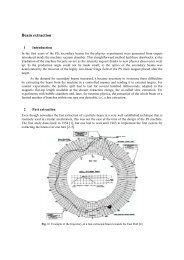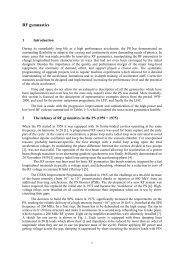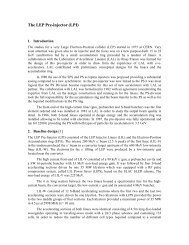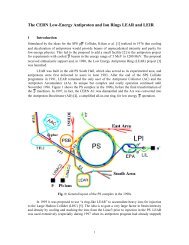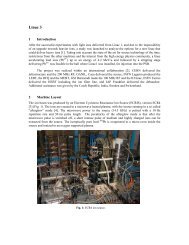Setting the Scene The history of CERN and its accelerators dates ...
Setting the Scene The history of CERN and its accelerators dates ...
Setting the Scene The history of CERN and its accelerators dates ...
You also want an ePaper? Increase the reach of your titles
YUMPU automatically turns print PDFs into web optimized ePapers that Google loves.
as <strong>the</strong> Secretary General. Four Study Groups were established: <strong>The</strong>ory under N. Bohr,<br />
Laboratory services under L. Kowarski, Synchrocyclotron under C. Bakker, <strong>and</strong> Proton<br />
Synchrotron under O. Dahl with F. Goward as deputy. Fur<strong>the</strong>r members <strong>of</strong> <strong>the</strong> PS Group<br />
were H. Alfvén, J. Fry, W. Gentner, K. Johnsen, E. Regenstreif, Chr. Schmelzer <strong>and</strong> R.<br />
Wideröe. From here on we shall follow in some detail <strong>the</strong> activities <strong>of</strong> <strong>the</strong> latter group.<br />
At end June 1952 <strong>the</strong> PS Group presented a first proposal for <strong>the</strong> construction <strong>of</strong> a 10 to<br />
15 GeV proton synchrotron, intended to be an up-scaled version <strong>of</strong> <strong>the</strong> 3 GeV Cosmotron<br />
at Brookhaven, which just had accelerated protons to more than 1 GeV in May <strong>of</strong> that<br />
year. Council asked that a detailed design <strong>and</strong> planning for a 10 GeV machine be<br />
presented by November 1953.<br />
Three members <strong>of</strong> <strong>the</strong> group, Dahl, Goward <strong>and</strong> Wideröe, visited Brookhaven during <strong>the</strong><br />
first two weeks <strong>of</strong> August 1952 so as to learn about details <strong>of</strong> <strong>the</strong> Cosmotron. <strong>The</strong><br />
Cosmotron team discussed, in anticipation <strong>of</strong> <strong>the</strong> visit, possible improvements to <strong>the</strong>ir<br />
machine design, <strong>and</strong> discovered during <strong>the</strong>se reflections a new way <strong>of</strong> beam focusing (5).<br />
<strong>The</strong> visitors were thus introduced, to <strong>the</strong>ir great surprise, to a br<strong>and</strong>-new idea, alternatinggradient<br />
or ‘strong’ focusing <strong>of</strong> particle beams, which would reduce by a large factor <strong>the</strong><br />
size <strong>of</strong> <strong>the</strong> vacuum chamber containing <strong>the</strong> beam <strong>and</strong> hence <strong>the</strong> magnet providing <strong>the</strong><br />
guide field. An accelerator <strong>of</strong> higher energy could thus be built within a given budget.<br />
Upon returning home <strong>the</strong> PS Group was faced with a very difficult decision: going ahead<br />
on <strong>the</strong> proven trail (which anyway was new territory for most <strong>of</strong> <strong>the</strong>m) or changing<br />
course <strong>and</strong> proceed with <strong>the</strong> new <strong>and</strong> untried idea. It might have been a deadly blow to<br />
<strong>the</strong> young team if <strong>the</strong>y found <strong>the</strong>mselves in a dead alley. But one could also hope that a<br />
machine <strong>of</strong> classical design might in this case‘ only’ be delayed by a year or so. O. Dahl<br />
strongly advocated an intense study <strong>of</strong> <strong>the</strong> strong focusing system <strong>and</strong> obtained Council<br />
approval at <strong>its</strong> third session in October 1952 at Amsterdam, which also saw <strong>the</strong> decision<br />
for Geneva as <strong>the</strong> location <strong>of</strong> <strong>the</strong> future laboratory.<br />
O. Dahl in his presentation to Council gave due warning <strong>of</strong> <strong>the</strong> risks involved in that<br />
choice but pointed out that a project based on <strong>the</strong> ‘classical’ design could not now be<br />
defended in view <strong>of</strong> <strong>the</strong> possible advantages inherent in <strong>the</strong> new invention. In fact, it was<br />
expected that a synchrotron <strong>of</strong> 30 GeV might be built at <strong>the</strong> same cost as a Cosmotrontype<br />
machine <strong>of</strong> 10 GeV (for which however no reliable cost estimate existed at that<br />
moment).<br />
<strong>The</strong> successful development <strong>of</strong> <strong>CERN</strong> during more than 5 decades was largely due to <strong>the</strong><br />
surprising flexibility <strong>of</strong> <strong>the</strong> alternating-gradient PS. <strong>CERN</strong> would surely have developed<br />
in a very different way, had this courageous decision not been taken.<br />
In fact, as <strong>the</strong> <strong>the</strong>ory <strong>of</strong> <strong>the</strong> alternating gradient synchrotron was developed, two serious<br />
problems were soon discovered: first, <strong>the</strong> stronger <strong>the</strong> focusing, <strong>the</strong> higher a precision <strong>of</strong><br />
<strong>the</strong> magnet field <strong>and</strong> <strong>of</strong> <strong>the</strong> alignment <strong>of</strong> <strong>the</strong> magnets is required. If <strong>the</strong> tight tolerances<br />
were not met, <strong>the</strong> beam would be lost due to resonance blow-up <strong>of</strong> <strong>the</strong> ‘betatron’<br />
oscillations <strong>of</strong> <strong>the</strong> protons about <strong>the</strong> equilibrium orbit (6). Secondly, <strong>the</strong> beam looses



